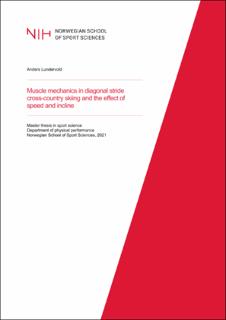| dc.description.abstract | Background: In gaits, such as running and walking, decoupling of the muscle fascicles length changes from the length changes of whole muscle-tendon unit (MTU), allows muscle fascicles to work almost isometrically and close to its optimal length, and therefore the fascicles can generate high forces economically. This is possible because the compliant tendons are stretch in the first part of the stance phase, facilitating storage of elastic strain energy within the elastic elements (EE), which, then is returned in the last part of stance. The storage and release of energy by the EE contributes substantially to the work done by the MTU during locomotion, thus decreasing the demand for muscle work. It has been speculated that a similar muscle-tendon dynamic to running takes place during a diagonal stride (DIA) in cross-country (XC) skiing, and that skiers store elastic energy in the preload phase prior to the kick. However, in vivo measurements of the fascicle length and contractions velocity, while the skiers perform diagonal stride, has not been conducted.
Purpose: The purpose of the study was to explore gastrocnemius medialis (GM) muscletendon mechanics during DIA on roller skies in vivo, and to examine the effects of different speeds and inclines on muscle-tendon behavior. Firstly, we hypothesize that propulsion in the kick phase is generated by concentric muscle contraction in the GM muscle while the MTU undergoes a stretch-shortening cycle. Furthermore, we believe that muscle contraction is initiated during the late part of the glide phase. Secondly, we hypothesize that the muscletendon behavior during the kick phase is affected by increase in speed and incline.
Methods: 13 elite senior XC skiers (age 26.5 ± 4.8 years) roller skied on a treadmill using diagonal stride (DIA) under three different conditions: (speed: 2.5 m s-1, incline: 5°) named DIAref, (speed: 3.5 m s-1, incline: 5°) named DIAfast, and (speed: 2.5 m s-1, incline: 10°) named DIAsteep. Ultrasound measurements of the GM muscle fascicle length was synchronized with kinematic, kinetic, and muscle activity (EMG) measurements of the right leg. A single-sided One-Sample T-tests were used to test muscle-tendon unit (MTU) behavior in DIAref. One way repeated-measures ANOVAs were used to test how the increase in speed and incline affected the MTU behavior.
Results: There is a stretch shortening cycle of the MTU during the kick phase, with a significant stretch in the first part 9.91 ± 0.29 mm (P<.0001), followed by a significant shortening 24.29 ± 7.79 mm (P<.0001). The GM muscle fascicles shortened throughout the entire kick phase 9.1 ± 2.7 mm (P<.0001). There was a significant stretch of the MTU in the late glide phase, whilst there was no change in fascicle length. The GM muscle is significantly active during the kick phase, but not significantly active in the late glide phase. Both increase in speed and incline increased MTU stretch (P<.0001). There was no significant difference in fascicle shortening velocity between DIAref and DIAfast, whereas the fascicle shortening velocity decreased with increased incline (P<.0007). Integrated EMG (iEMG) was significantly higher in DIAsteep compared to DIAref, whereas DIAref and DIAfast did not differ.
Conclusion: This study showed that during the kick phase of DIA XC-skiing, the GM muscle fascicle shortens continuously, whereas the MTU lengthens in the first part of the kick phase, allowing for storage of elastic energy, which is released later in the kick phase when the MTU shortens rapidly. We found no conclusive evidence for storage of elastic energy being initiated in the glide phase. Fascicle shortening velocity did not increase with higher speeds, however at increased incline the fascicle shortening velocity decreased. This is due to how the muscle-tendon interact under different time constraint and requirement for force and work. The increased demand at higher speeds is met by higher relative contribution of the tendons to the force generated (i.e., increased stretch and recoil of energy). The increased demand at increased incline is met by a longer kick phase, allowing fascicles to operate at lower shortening velocities and at a more favorable part of the force-velocity curve to produce higher forces. | en_US |
